On the Mobile Communication Requirements for the Demand-Side Management of Electric Vehicles
Abstract
1. Introduction
- the proposal of a specific system architecture, including a proper data exchange procedure for the DSM of EVs moving inside urban areas;
- the analysis of such an architecture in terms of communication requirements (e.g., the latency and data throughput);
- the evaluation of the feasibility of such an architecture for a real use case of EV management, by means of the experimental evaluation of a real-world test bed.
2. Interaction among Electric Vehicles (EVs) and Power Grids
2.1. Electric Vehicle (EV) Batteries Power Supply Systems
2.2. The Smart Charging Concept
2.3. Discussion
3. Demand-Side Management (DSM) Schemes for EV Smart Charging
3.1. Demand-Side Management (DSM) Schemes in Vehicle-to-Grid (V2G) Applications
3.2. Communication Requirements
4. The Proposed System Architecture for the Intraday DSM of EVs
4.1. System Architecture
4.2. Data Exchange Procedure
4.2.1. EV Monitoring
4.2.2. Provisioning of EV Supply Equipment (EVSE) Information to EV Users
4.2.3. Management of Vehicle-to-Grid (V2G) Demand Response (DR) Requests
5. The Communication Infrastructure
- the long-range capability, allowed by the use of unlicensed sub-GHz bands, and by the adoption of simple modulation techniques, offering very high receiver sensitivity;
- the low power consumption of nodes, allowed by the star topology configuration, and by the low duty-cycle of each node;
- the high scalability, allowed by the exploitation of several diversity techniques and complemented by adaptive channels and data rate selection;
- the low cost of nodes, allowed by the use of simple radio technologies, and by the lightweight protocol stack on the node side, which offloads most of the complexity to a network manager.
5.1. The Long-Range Wide Area Network (LoRaWAN) Architecture
5.2. The LoRaWAN Communication Protocol Stack
5.3. Scalability of the Proposed Low-Power Wide-Area Network (LPWAN) Infrastructure
6. Experimental Validation
6.1. Experimental Set-up
6.2. Experimental Results
7. Conclusions
Author Contributions
Acknowledgments
Conflicts of Interest
References
- Beretta, G.P. World energy consumption and resources: An outlook for the rest of the century. Int. J. Environ. Technol. Manag. 2007, 7, 99–112. [Google Scholar] [CrossRef]
- Intergovernmental Panel on Climate Change (IPCC). Climate Change 2014: Mitigation of Climate Change. Contribution of Working Group III to the Fifth Assessment Report of the Intergovernmental Panel on Climate Change; Edenhofer, O., Pichs-Madruga, R., Sokona, Y., Farahani, E., Kadner, S., Seyboth, K., Adler, A., Baum, I., Brunner, S., Eickemeier, P., et al., Eds.; Cambridge University Press: Cambridge, UK, 2014; ISBN 9781107415416. [Google Scholar]
- Fraile-Ardanuy, J.; Castano-Solis, S.; Álvaro-Hermana, R.; Merino, J.; Castillo, Á. Using mobility information to perform a feasibility study and the evaluation of spatio-temporal energy demanded by an electric taxi fleet. Energy Convers. Manag. 2018, 157, 59–70. [Google Scholar] [CrossRef]
- Morganti, E.; Browne, M. Technical and operational obstacles to the adoption of electric vans in France and the UK: An operator perspective. Transp. Policy 2018, 63, 90–97. [Google Scholar] [CrossRef]
- Onat, N.C.; Kucukvar, M.; Tatari, O. Conventional, hybrid, plug-in hybrid or electric vehicles? State-based comparative carbon and energy footprint analysis in the United States. Appl. Energy 2015, 150, 36–49. [Google Scholar] [CrossRef]
- Ferrero, E.; Alessandrini, S.; Balanzino, A. Impact of the electric vehicles on the air pollution from a highway. Appl. Energy 2016, 169, 450–459. [Google Scholar] [CrossRef]
- Buekers, J.; Van Holderbeke, M.; Bierkens, J.; Panis, L.I. Health and environmental benefits related to electric vehicle introduction in EU countries. Transp. Res. Part D Transp. Environ. 2014, 33, 26–38. [Google Scholar] [CrossRef]
- Shareef, H.; Islam, M.M.; Mohamed, A. A review of the stage-of-the-art charging technologies, placement methodologies, and impacts of electric vehicles. Renew. Sustain. Energy Rev. 2016, 64, 403–420. [Google Scholar] [CrossRef]
- International Energy Agency (IEA). Global EV Outlook 2017: Two Million and Counting; IEA: Washington, DC, USA, June 2017. [Google Scholar]
- Dominković, D.F.; Bačeković, I.; Pedersen, A.S.; Krajačić, G. The future of transportation in sustainable energy systems: Opportunities and barriers in a clean energy transition. Renew. Sustain. Energy Rev. 2018, 82, 1823–1838. [Google Scholar] [CrossRef]
- Habib, S.; Kamran, M.; Rashid, U. Impact analysis of vehicle-to-grid technology and charging strategies of electric vehicles on distribution networks—A review. J. Power Sources 2015, 277, 205–214. [Google Scholar] [CrossRef]
- Mahmud, K.; Town, G.E.; Morsalin, S.; Hossain, M.J. Integration of electric vehicles and management in the internet of energy. Renew. Sustain. Energy Rev. 2018, 82, 4179–4203. [Google Scholar] [CrossRef]
- Godina, R.; Paterakis, N.G.; Erdinç, O.; Rodrigues, E.M.G.; Catalão, J.P.S. Impact of EV charging-at-work on an industrial client distribution transformer in a Portuguese Island. In Proceedings of the Australasian Universities Power Engineering Conference (AUPEC), Wollongong, Australia, 27–30 September 2015; IEEE: Wollongong, Australia, 2016. [Google Scholar]
- Rahman, I.; Vasant, P.M.; Singh, B.S.M.; Abdullah-Al-Wadud, M.; Adnan, N. Review of recent trends in optimization techniques for plug-in hybrid, and electric vehicle charging infrastructures. Renew. Sustain. Energy Rev. 2016, 58, 1039–1047. [Google Scholar] [CrossRef]
- Liu, L.; Kong, F.; Liu, X.; Peng, Y.; Wang, Q. A review on electric vehicles interacting with renewable energy in smart grid. Renew. Sustain. Energy Rev. 2015, 51, 648–661. [Google Scholar] [CrossRef]
- Tan, K.M.; Ramachandaramurthy, V.K.; Yong, J.Y. Integration of electric vehicles in smart grid: A review on vehicle to grid technologies and optimization techniques. Renew. Sustain. Energy Rev. 2016, 53, 720–732. [Google Scholar] [CrossRef]
- Schuller, A. Charging coordination paradigms of electric vehicles. Power Syst. 2015, 88. [Google Scholar] [CrossRef]
- Ziekow, H.; Goebel, C.; Strüker, J.; Jacobsen, H.A. The potential of smart home sensors in forecasting household electricity demand. In Proceedings of the International Conference on Smart Grid Communications (SmartGridComm), Vancouver, BC, Canada, 21–24 October 2013; pp. 229–234. [Google Scholar] [CrossRef]
- Hu, J.; Morais, H.; Sousa, T.; Lind, M. Electric vehicle fleet management in smart grids: A review of services, optimization and control aspects. Renew. Sustain. Energy Rev. 2016, 56, 1207–1226. [Google Scholar] [CrossRef]
- Rinaldi, S.; Pasetti, M.; Ferrari, P.; Massa, G.; Della Giustina, D. Experimental characterization of communication infrastructure for virtual power plant monitoring. In Proceedings of the IEEE International Workshop on Applied Measurements for Power Systems (AMPS), Aachen, Germany, 28–30 September 2016; IEEE: Aachen, Germany, 2016; pp. 1–6. [Google Scholar]
- Rinaldi, S.; Della Giustina, D.; Ferrari, P.; Flammini, A.; Sisinni, E. Time synchronization over heterogeneous network for smart grid application: Design and characterization of a real case. Ad Hoc Netw. 2016, 50, 41–57. [Google Scholar] [CrossRef]
- Mwasilu, F.; Justo, J.J.; Kim, E.-K.; Do, T.D.; Jung, J.-W. Electric vehicles and smart grid interaction: A review on vehicle to grid and renewable energy sources integration. Renew. Sustain. Energy Rev. 2014, 34, 501–516. [Google Scholar] [CrossRef]
- Kiokes, G.; Zountouridou, E.; Papadimitriou, C.; Dimeas, A.; Hatziargyriou, N. Development of an Integrated Wireless Communication System for Connecting Electric Vehicles to the Power Grid. In Proceedings of the International Symposium on Smart Electric Distribution Systems and Technologies (EDST), Vienna, Austria, 8–11 September 2015; IEEE: Vienna, Austria, 2015; pp. 296–301. [Google Scholar]
- Siegel, J.E.; Erb, D.C.; Sarma, S.E. A Survey of the Connected Vehicle Landscape—Architectures, Enabling Technologies, Applications, and Development Areas. IEEE Trans. Intell. Transp. Syst. 2017, 1–16. [Google Scholar] [CrossRef]
- Saltanovs, R.; Krivchenkov, A.; Krainyukov, A. Analysis of effective wireless communications for V2G applications and mobile objects. In Proceedings of the 58th International Scientific Conference on Power and Electrical Engineering of Riga Technical University (RTUCON), Riga, Latvia, 12–13 October 2017; IEEE: Riga, Latvia, 2017. [Google Scholar]
- Rizzi, M.; Ferrari, P.; Flammini, A.; Sisinni, E.; Gidlund, M. Using LoRa for industrial wireless networks. In Proceedings of the IEEE International Workshop on Factory Communication Systems (WFCS), Trondheim, Norway, 31 May–2 June 2017; IEEE: Trondheim, Norway, 2017. [Google Scholar]
- Wang, L.; Sharkh, S.; Chipperfield, A. Optimal decentralized coordination of electric vehicles and renewable generators in a distribution network using A∗ search. Int. J. Electr. Power Energy Syst. 2018, 98, 474–487. [Google Scholar] [CrossRef]
- Bahramara, S.; Golpîra, H. Robust optimization of micro-grids operation problem in the presence of electric vehicles. Sustain. Cities Soc. 2018, 37, 388–395. [Google Scholar] [CrossRef]
- Ul-Haq, A.; Cecati, C.; El-Saadany, E. Probabilistic modeling of electric vehicle charging pattern in a residential distribution network. Electr. Power Syst. Res. 2018, 157, 126–133. [Google Scholar] [CrossRef]
- Mureddu, M.; Facchini, A.; Scala, A.; Caldarelli, G.; Damiano, A. A Complex Network Approach for the Estimation of the Energy Demand of Electric Mobility. Sci. Rep. 2018, 8, 1–8. [Google Scholar] [CrossRef] [PubMed]
- Shao, C.; Wang, X.; Shahidehpour, M.; Wang, X.; Wang, B. Partial Decomposition for Distributed Electric Vehicle Charging Control Considering Electric Power Grid Congestion. IEEE Trans. Smart Grid 2017, 8, 75–83. [Google Scholar] [CrossRef]
- Morshed, M.J.; Hmida, J.B.; Fekih, A. A probabilistic multi-objective approach for power flow optimization in hybrid wind-PV-PEV systems. Appl. Energy 2018, 211, 1136–1149. [Google Scholar] [CrossRef]
- Zhu, J.; Jiang, P.; Gu, W.; Sheng, W.; Meng, X.; Gao, J. Finite Action-Set Learning Automata for Economic Dispatch Considering Electric Vehicles and Renewable Energy Sources. Energies 2014, 7, 4629–4647. [Google Scholar] [CrossRef]
- Wei, Z.; Li, Y.; Zhang, Y.; Cai, L. Intelligent parking garage EV charging scheduling considering battery charging characteristic. IEEE Trans. Ind. Electron. 2018, 65, 2806–2816. [Google Scholar] [CrossRef]
- Ji, Z.; Huang, X.; Xu, C.; Sun, H. Accelerated Model Predictive Control for Electric Vehicle Integrated Microgrid Energy Management: A Hybrid Robust and Stochastic Approach. Energies 2016, 9, 973. [Google Scholar] [CrossRef]
- Milanés-Montero, M.I.; Martínez, M.A.G.; González-Romera, E.; Romero-Cadaval, E.; Barrero-González, F. Active and Reactive Power Control Strategies for Electric Vehicles in Smart Grids. In Proceedings of the 10th International Conference on Compatibility, Power Electronics and Power Engineering (CPE-POWERENG), Bydgoszcz, Poland, 29 June–1 July 2016; pp. 114–119. [Google Scholar]
- Knezović, K.; Martinenas, S.; Andersen, P.B.; Zecchino, A.; Marinelli, M. Enhancing the Role of Electric Vehicles in the Power Grid: Field Validation of Multiple Ancillary Services. IEEE Trans. Transp. Electr. 2017, 3, 201–209. [Google Scholar] [CrossRef]
- Cheng, Y.-H.; Lai, C.-M. Control Strategy Optimization for Parallel Hybrid Electric Vehicles Using a Memetic Algorithm. Energies 2017, 10, 305. [Google Scholar] [CrossRef]
- Peng, J.; Fan, H.; He, H.; Pan, D. A rule-based energy management strategy for a plug-in hybrid school bus based on a controller area network bus. Energies 2015, 8, 5122–5142. [Google Scholar] [CrossRef]
- Gellings, C.W. The Concept of Demand-Side Management for Electric Utilities. Proc. IEEE 1985, 73, 1468–1470. [Google Scholar] [CrossRef]
- Gelazanskas, L.; Gamage, K.A.A. Demand side management in smart grid: A review and proposals for future direction. Sustain. Cities Soc. 2014, 11, 22–30. [Google Scholar] [CrossRef]
- Vardakas, J.S.; Zorba, N.; Verikoukis, C.V. A Survey on Demand Response Programs in Smart Grids: Pricing Methods and Optimization Algorithms. IEEE Commun. Surv. Tutor. 2015, 17, 152–178. [Google Scholar] [CrossRef]
- Siano, P. Demand response and smart grids—A survey. Renew. Sustain. Energy Rev. 2014, 30, 461–478. [Google Scholar] [CrossRef]
- Pasetti, M.; Rinaldi, S.; Manerba, D. A Virtual Power Plant Architecture for the Demand-Side Management of Smart Prosumers. Appl. Sci. 2018, 8, 432. [Google Scholar] [CrossRef]
- Yong, J.Y.; Ramachandaramurthy, V.K.; Tan, K.M.; Mithulananthan, N. A review on the state-of-the-art technologies of electric vehicle, its impacts and prospects. Renew. Sustain. Energy Rev. 2015, 49, 365–385. [Google Scholar] [CrossRef]
- Pahwa, A.; DeLoach, S.A.; Natarajan, B.; Das, S.; Malekpour, A.R.; Shafiul Alam, S.M.; Case, D.M. Goal-Based Holonic Multiagent System for Operation of Power Distribution Systems. IEEE Trans. Smart Grid 2015, 6, 2510–2518. [Google Scholar] [CrossRef]
- Rinaldi, S.; Pasetti, M.; Trioni, M.; Vivacqua, G. On the Integration of E-Vehicle Data for Advanced Management of Private Electrical Charging Systems. In Proceedings of the IEEE International Instrumentation and Measurement Technology Conference (I2MTC), Turin, Italy, 22–25 May 2017; IEEE: Turin, Italy, 2017. [Google Scholar]
- Yasmin, R.; Petäjäjärvi, J.; Mikhaylov, K.; Pouttu, A. On the Integration of LoRaWAN with the 5G Test Network. In Proceedings of the 28th Annual International Symposium on Personal, Indoor, and Mobile Radio Communications (PIMRC), Montreal, QC, Canada, 8–13 October 2017; IEEE: Montreal, QC, Canada, 2017. [Google Scholar]
- Navarro-Ortiz, J.; Sendra, S.; Ameigeiras, P.; Lopez-Soler, J.M. Integration of LoRaWAN and 4G/5G for the Industrial Internet of Things. IEEE Commun. Mag. 2018, 56, 60–67. [Google Scholar] [CrossRef]
- Adelantado, F.; Vilajosana, X.; Tuset-Peiro, P.; Martinez, B.; Melia-Segui, J.; Watteyne, T. Understanding the Limits of LoRaWAN. IEEE Commun. Mag. 2017, 55, 34–40. [Google Scholar] [CrossRef]
- Bankov, D.; Khorov, E.; Lyakhov, A. On the limits of LoRaWAN channel access. In Proceedings of the International Conference on Engineering and Telecommunication (EnT), Moscow, Russia, 29–30 November 2016; IEEE: Moscow, Russia, 2017; pp. 10–14. [Google Scholar]
- Van Den Abeele, F.; Haxhibeqiri, J.; Moerman, I.; Hoebeke, J. Scalability Analysis of Large-Scale LoRaWAN Networks in ns-3. IEEE Internet Things J. 2017, 4, 2186–2198. [Google Scholar] [CrossRef]
- Mikhaylov, K.; Petäjäjärvi, J.; Hänninen, T. Analysis of Capacity and Scalability of the LoRa Low Power Wide Area Network Technology. In Proceedings of the European Wireless 2016, Oulu, Finland, 18–20 May 2016; IEEE: Oulu, Finland, 2016; pp. 119–124. [Google Scholar]
- Hall, D.; Lutsey, N. Emerging Best Practices for Electric Vehicle Charging Infrastructure; The International Council on Clean Transportation (ICCT): Washington, DC, USA, 2017. [Google Scholar]
- Sanguesa, J.A.; Naranjo, F.; Torres-Sanz, V.; Fogue, M.; Garrido, P.; Martinez, F.J. On the Study of Vehicle Density in Intelligent Transportation Systems. Mob. Inf. Syst. 2016, 2016, 8320756. [Google Scholar] [CrossRef]
- A2A Smart City. Available online: http://www.a2asmartcity.io (accessed on 19 April 2018).
- QGIS Development Team QGIS Geographic Information System. Available online: https://www.qgis.org (accessed on 16 February 2018).
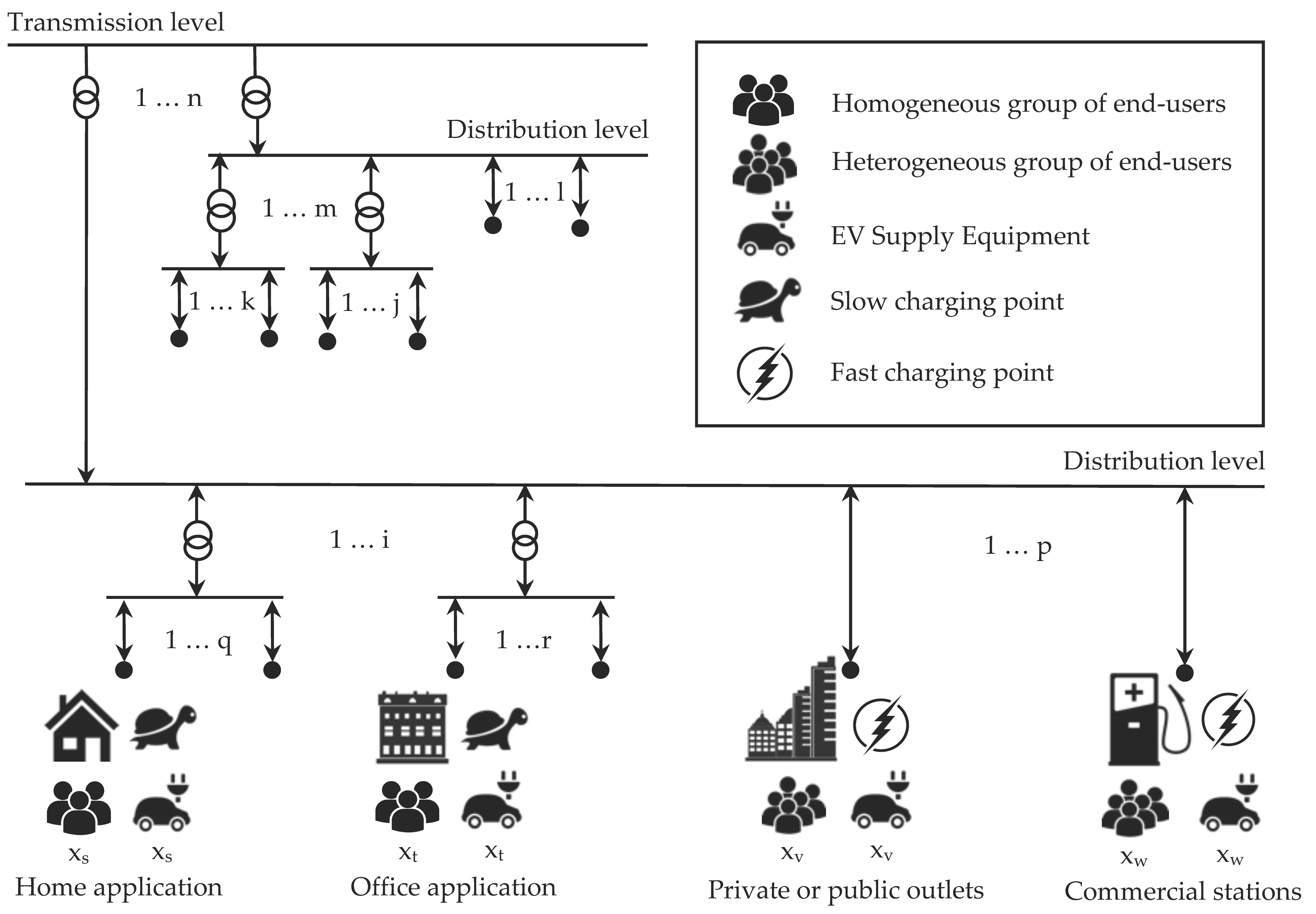
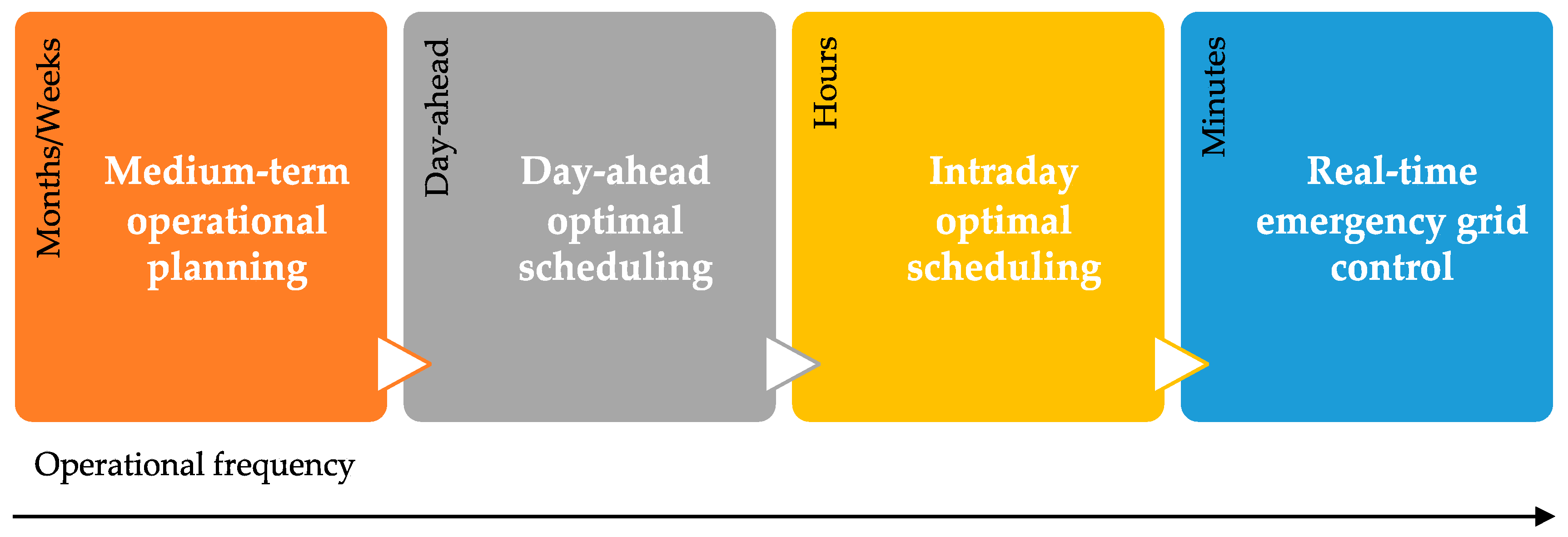
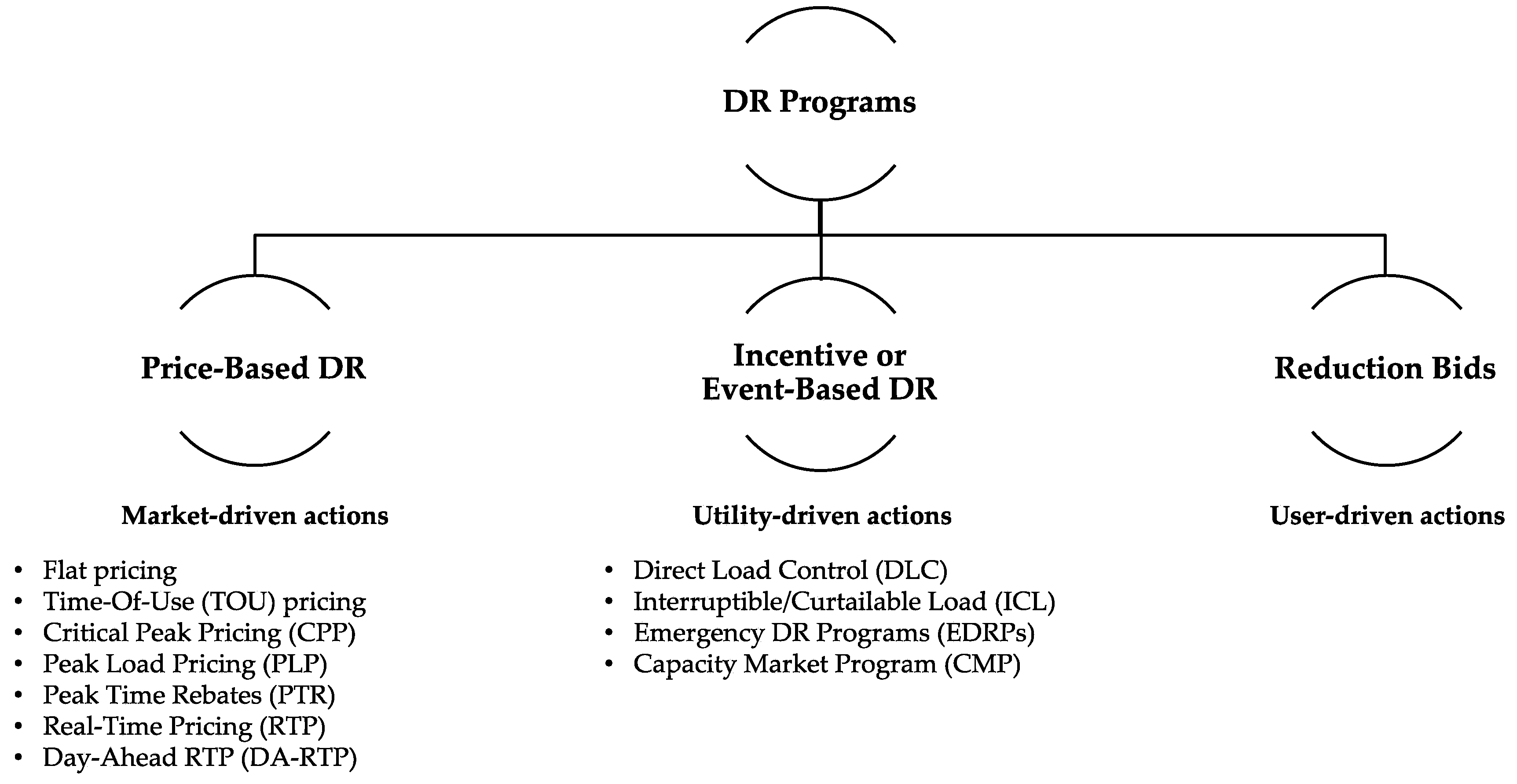

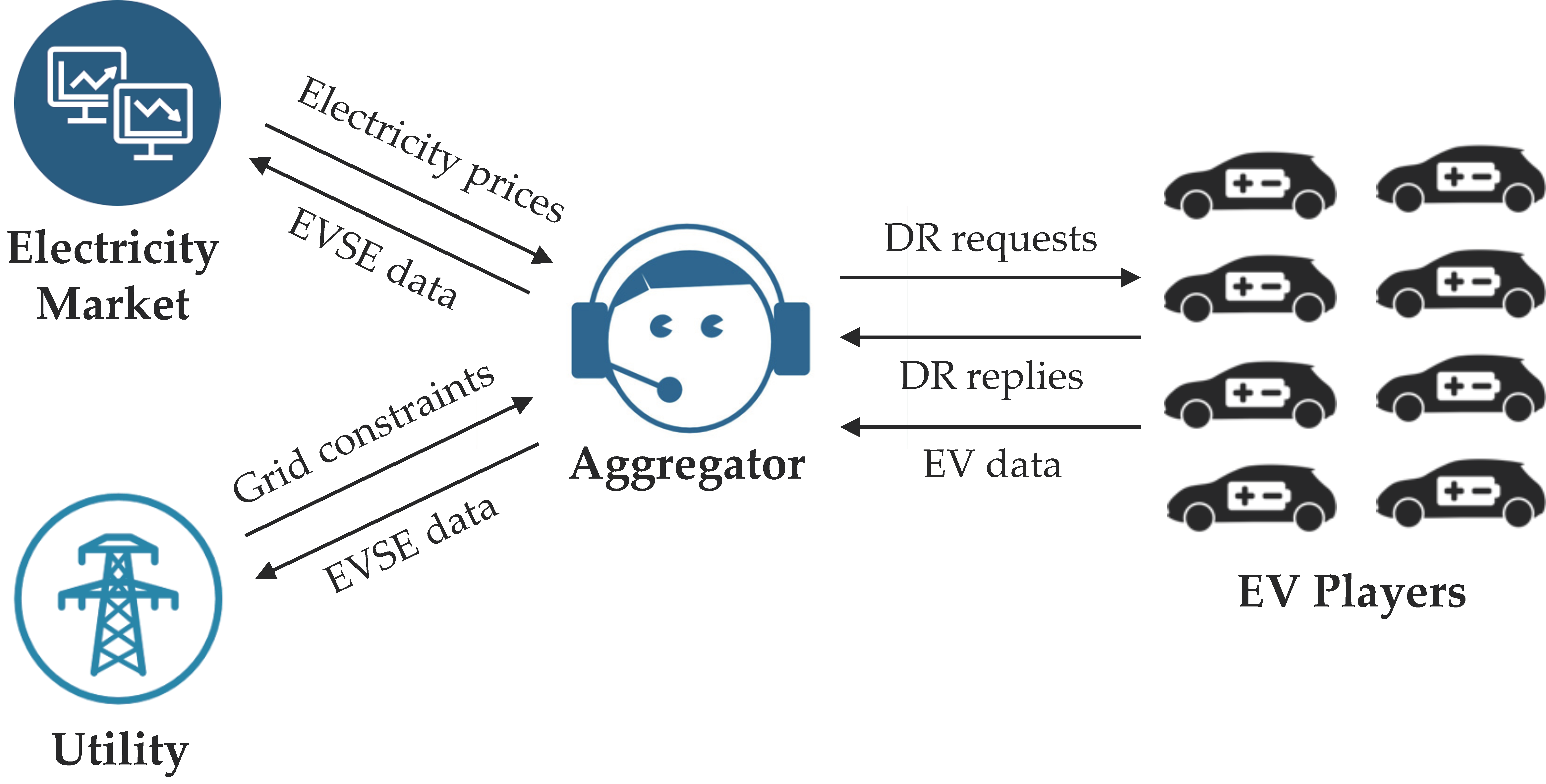
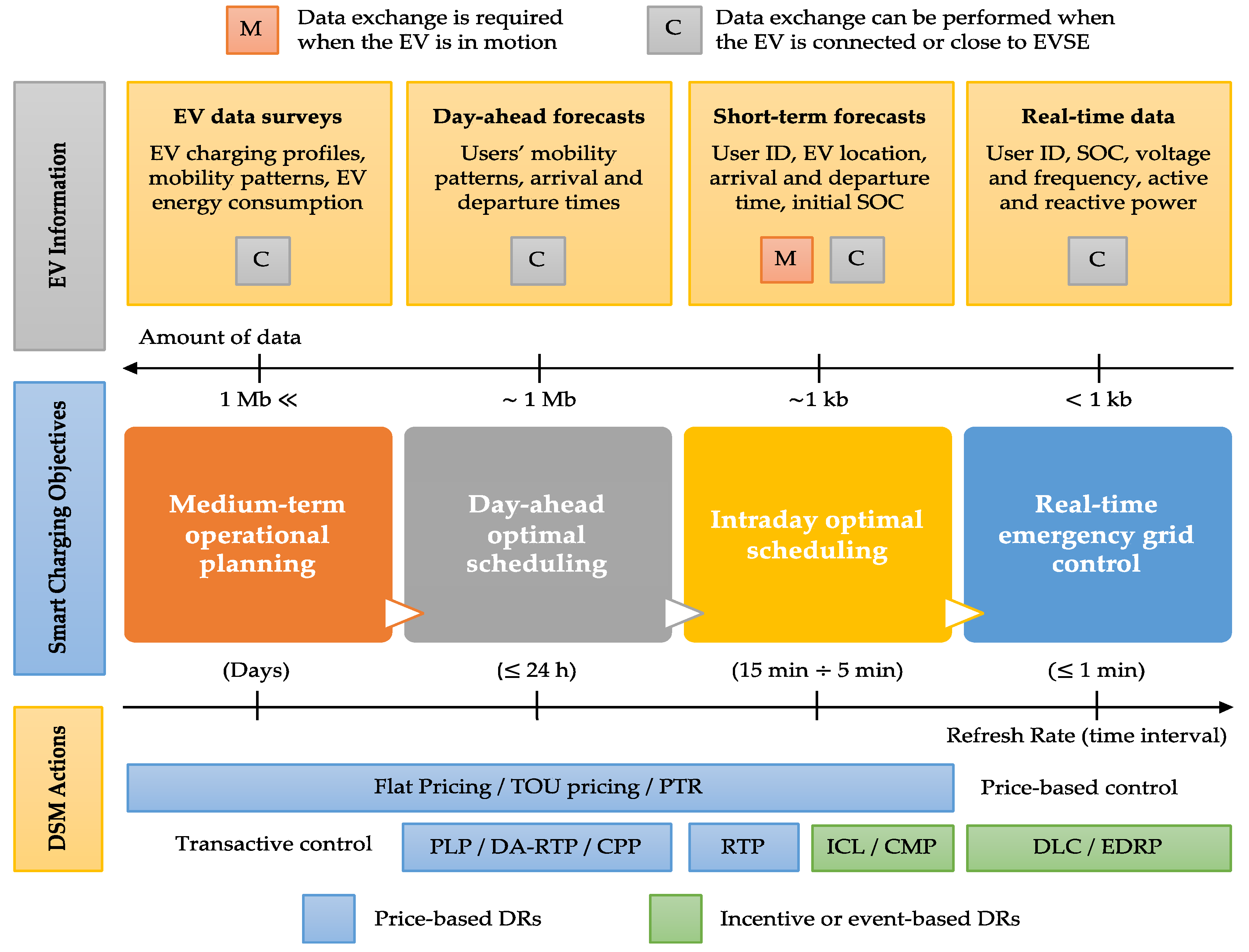
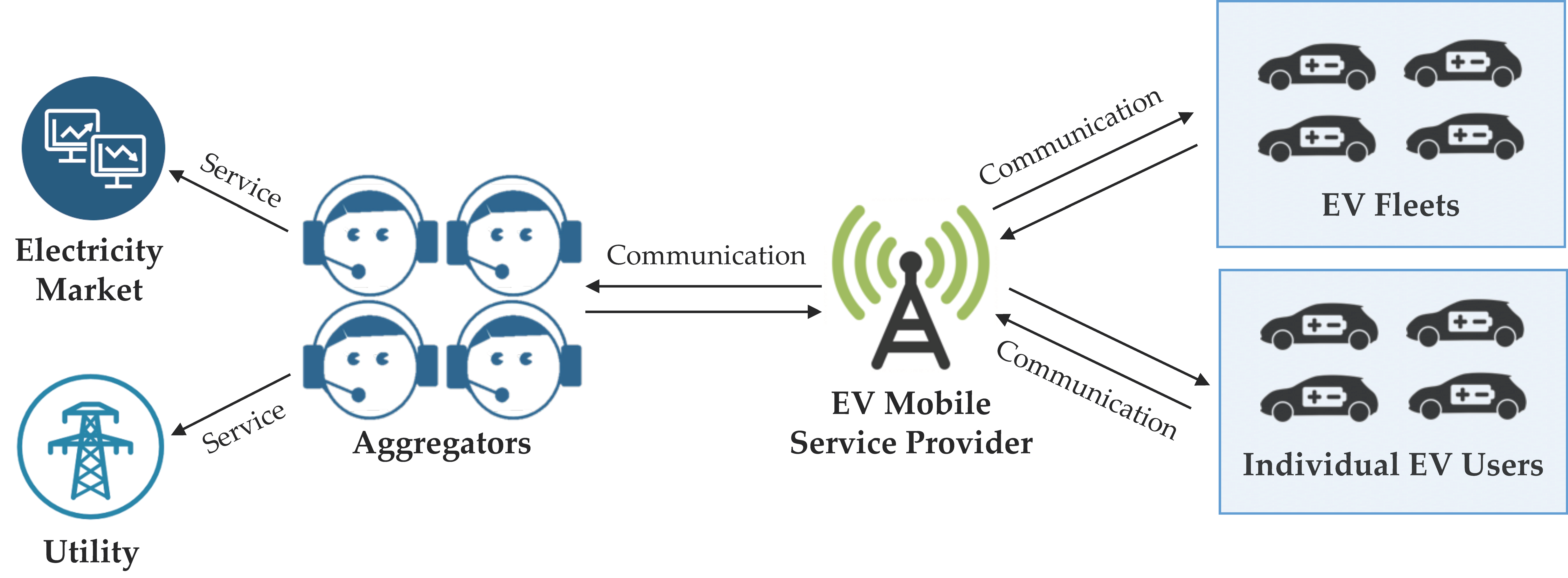
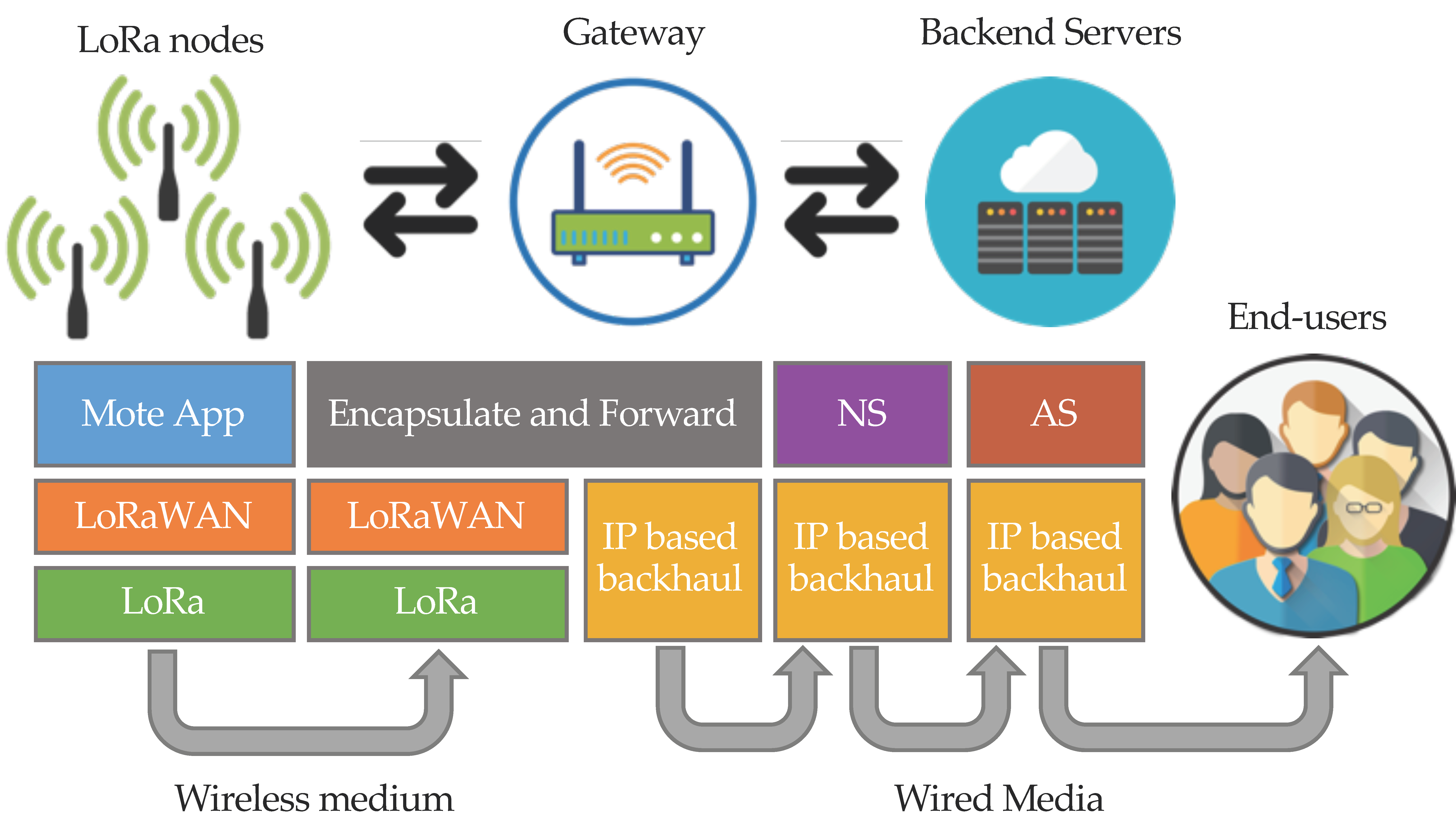
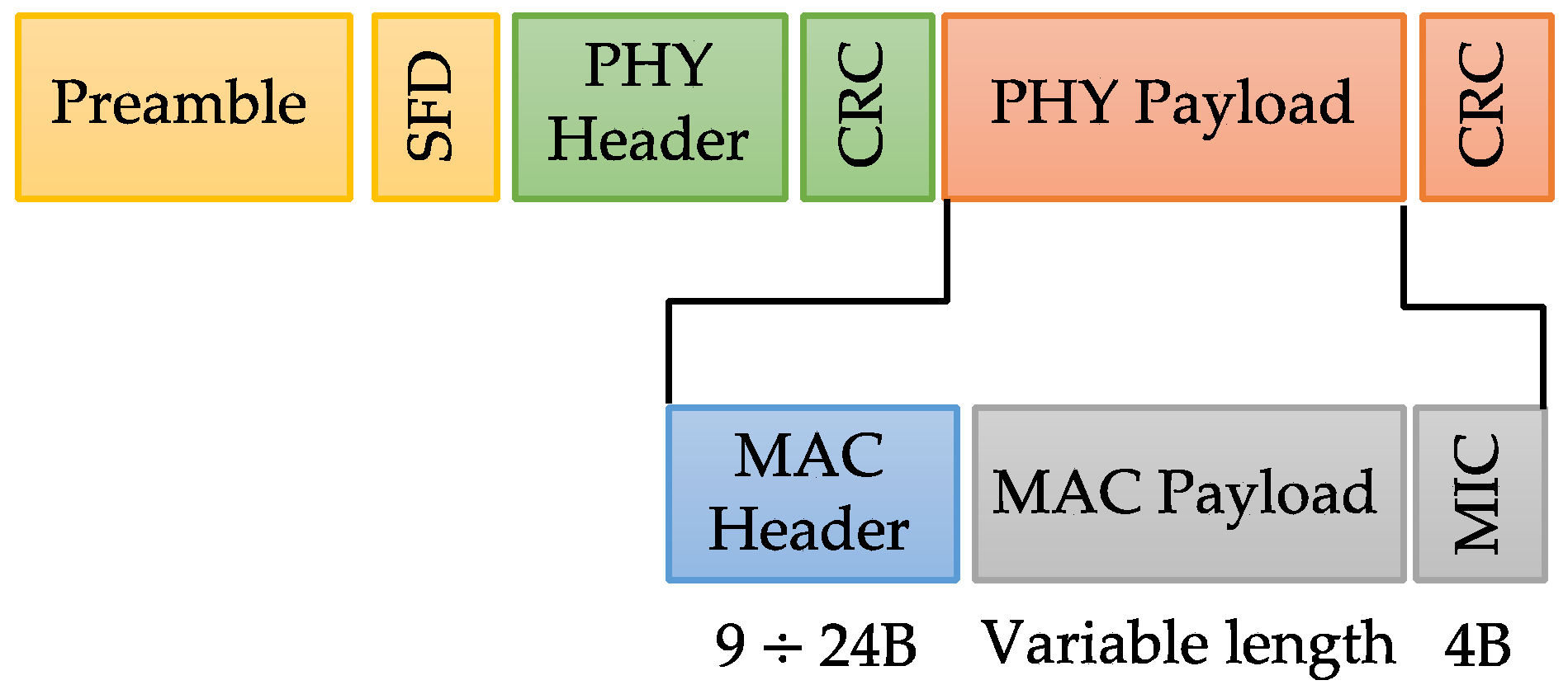
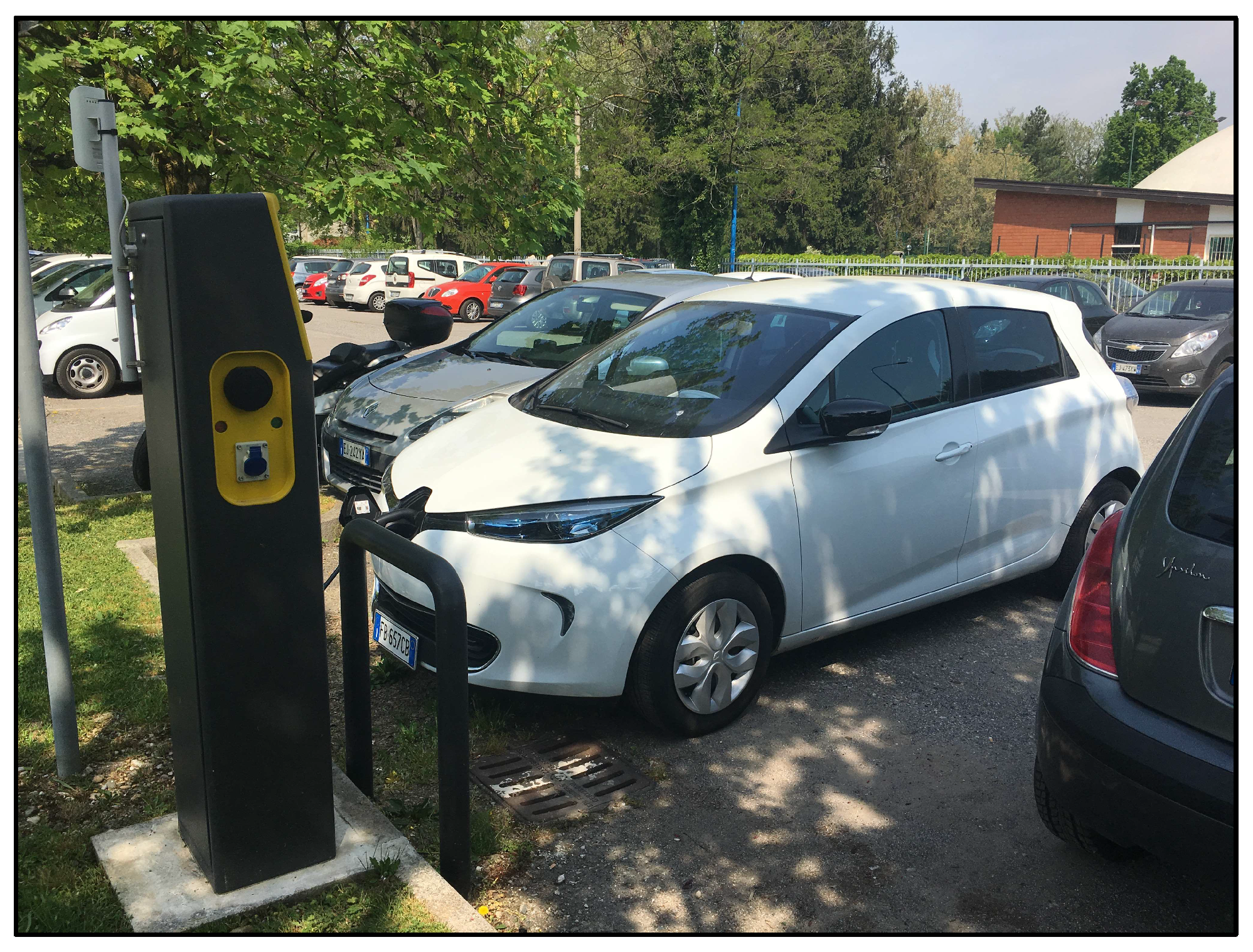
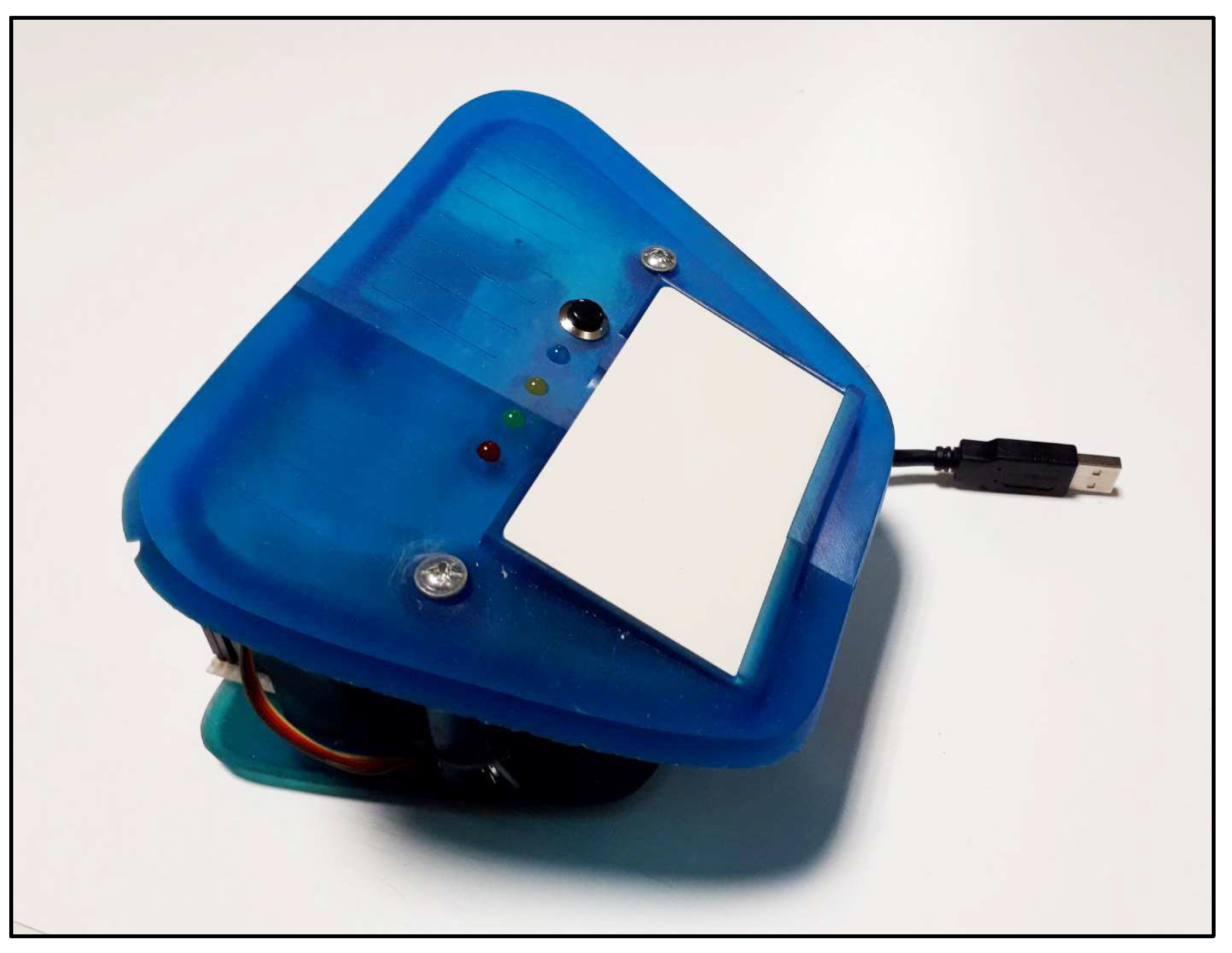
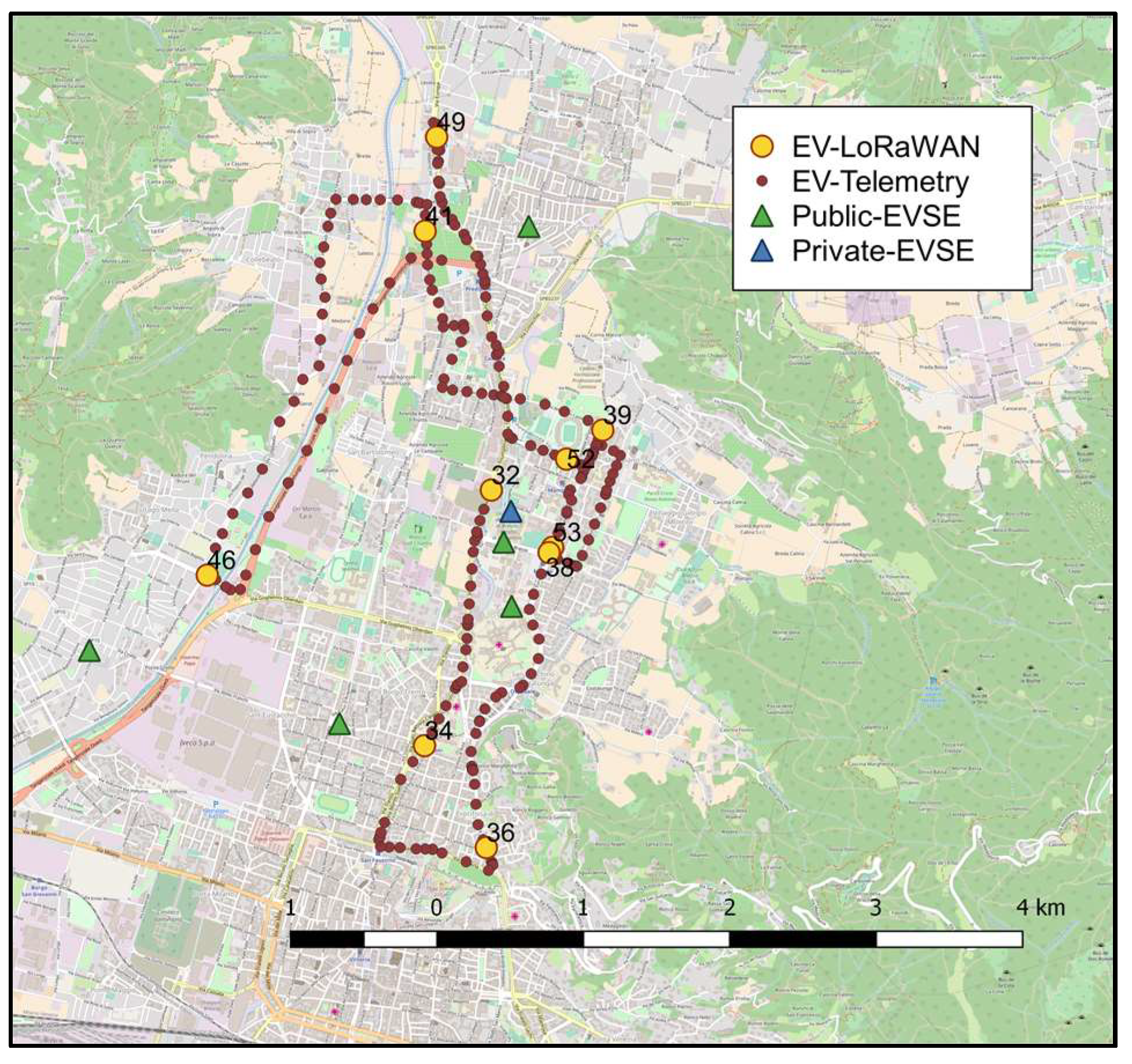
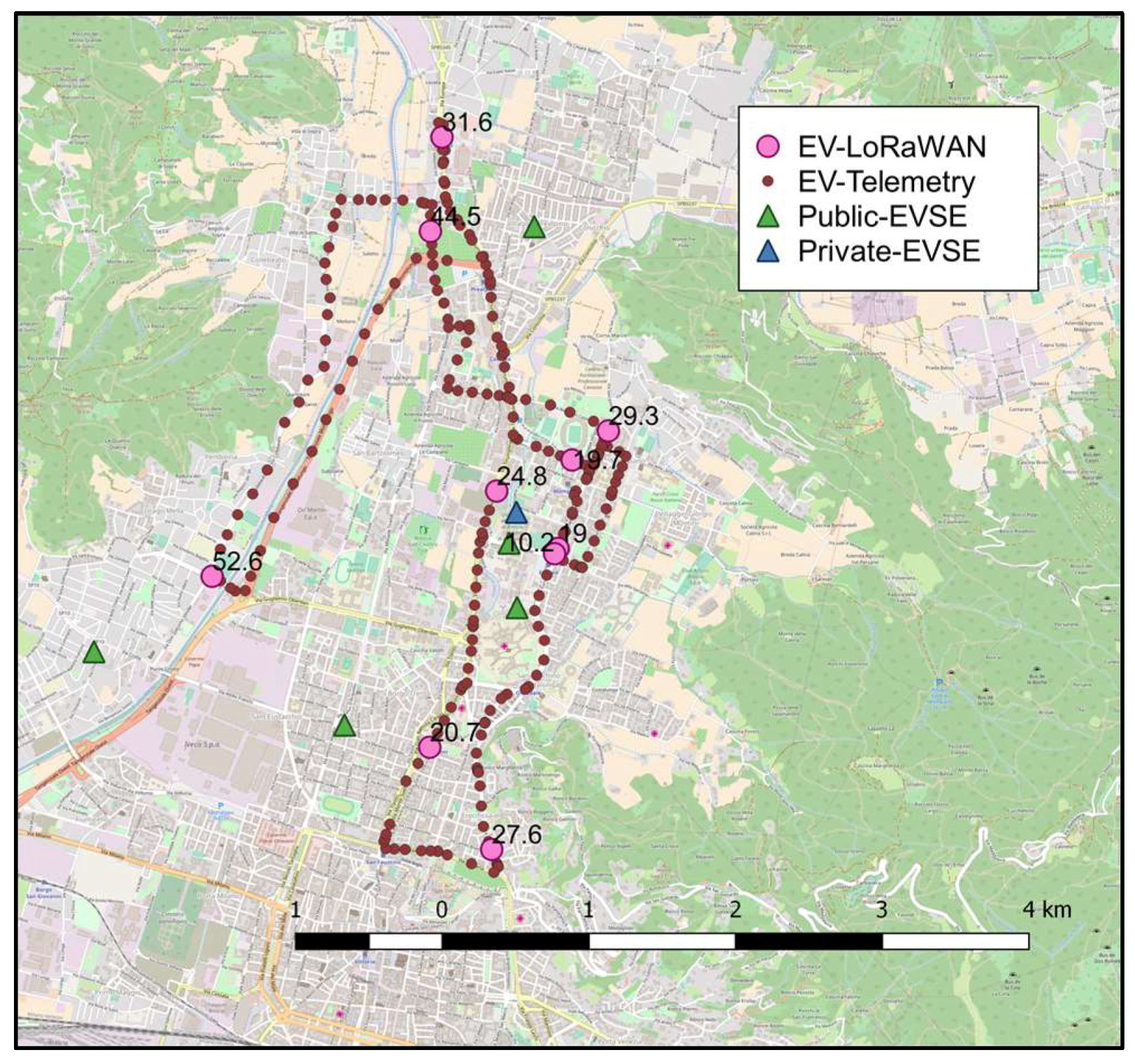
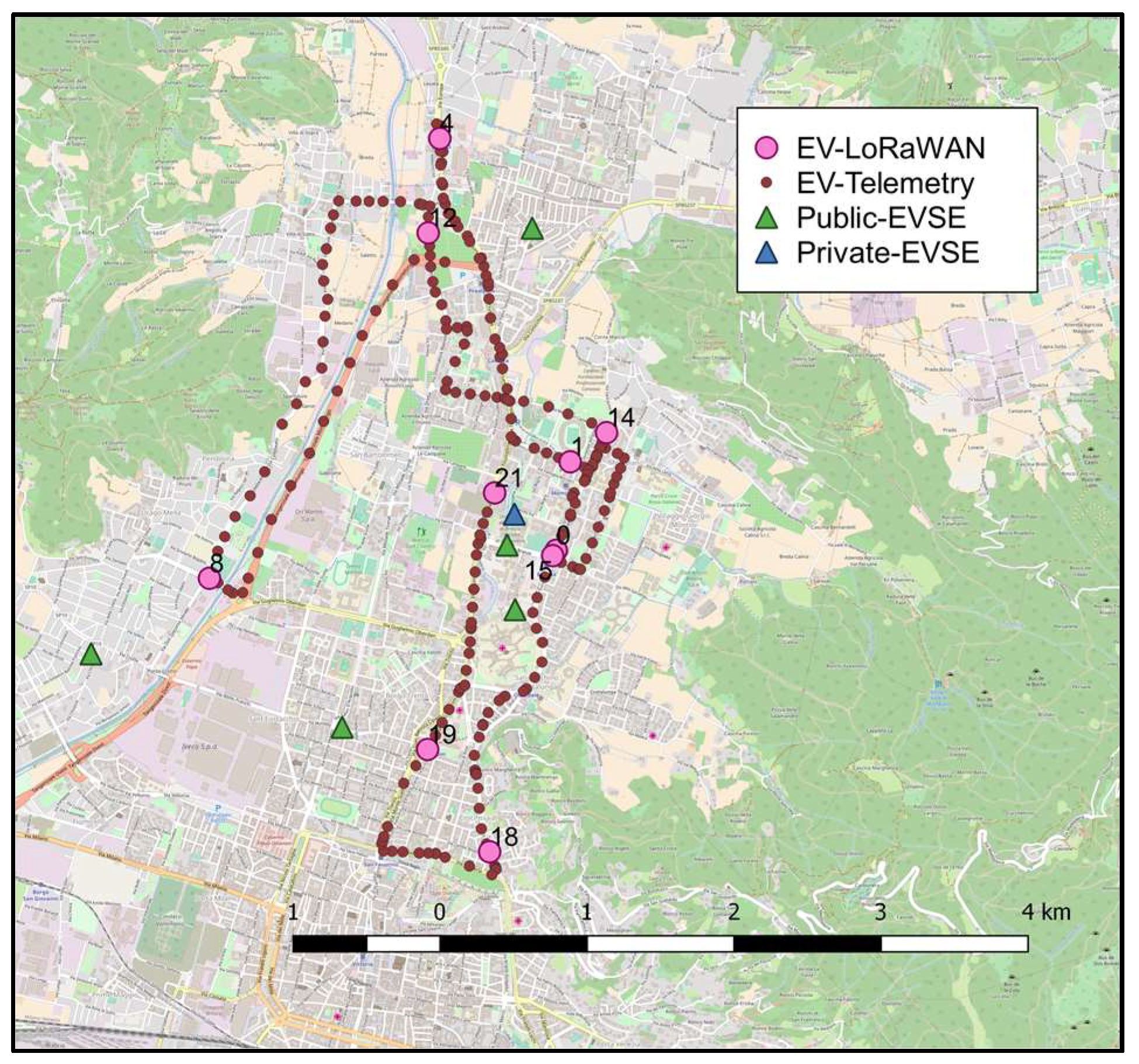
| SAE Level | AC/DC Power Converter | Maximum AC Power Supplied to EVSE (kW) | Charging Speed Level | Typical Use |
|---|---|---|---|---|
| AC Level 1 | On-board | 1.44 ÷ 1.92/single-phase | slow | Home or office |
| AC Level 2 | On-board | 7.7/single-phase | slow | Private or public |
| 25.6/three-phase | fast | |||
| DC Level 1 | Off-board | 13.3 ÷ 38.4/three-phase | fast | Public or commercial |
| DC Level 2 | Off-board | 33.3 ÷ 96/three-phase | fast | Public or commercial |
| Information | Resolution | Size (bit) |
|---|---|---|
| Timestamp of the set of information | 1 s | 38 |
| Identification code of the EV | - | 32 |
| Identification code of the EV model | - | 20 |
| Identification code of the EV user | - | 32 |
| Current GPS position of the EV | 11 m | 43 |
| Current state of charge of EV on-board batteries | 1% | 7 |
| GPS position of the planned destination (if available) | 11 m | 43 |
| Estimated time of arrival at the destination (if available) | 1 min | 32 |
| Information | Resolution | Size (bit) |
|---|---|---|
| Timestamp of the set of information | 1 s | 38 |
| Identification code of the charging station | - | 32 |
| GPS position of the charging station | 11 m | 43 |
| Number of available slow AC Level 2 EVSE within the next 3 h * | 60 | |
| Number of available fast AC Level 2 EVSE within the next 3 h * | - | 60 |
| Number of available DC Level 1 EVSE within the next 3 h * | - | 60 |
| Number of available DC Level 2 EVSE within the next 3 h * | - | 60 |
| Information | Resolution | Size (bit) |
|---|---|---|
| Identification code of the DR signal | - | 32 |
| Price profile over the next 3 h * | 1 € cent/kWh | 72 |
| Power limitation profile over the next 3 h * | 1 kW | 84 |
| Value of the incentive related to the power limitation DR request | 1 € cent | 12 |
| Information | Resolution | Size (bit) |
|---|---|---|
| Identification code of the DR signal | - | 32 |
| EVSE booking request: ETA * | 1 min | 32 |
| EVSE booking request: ETD * | 1 min | 32 |
| EVSE booking request: total amount of required energy * | 0.1 kWh | 10 |
| Acceptance of the power limitation defined by the DR request | - | 1 |
| Communication Parameters | Average Message Duration (TOA) | Cell Capacity Per Channel * | Cell Capacity Per Channel (Pure ALOHA Access) |
|---|---|---|---|
| SF = 7, B = 250 kHz | 726 ms | 413 | 74 |
| SF = 7, B = 125 kHz | 1452 ms | 206 | 37 |
| SF = 8, B = 125 kHz | 2546 ms | 117 | 21 |
| SF = 9, B = 125 kHz | 3720 ms | 80 | 14 |
© 2018 by the authors. Licensee MDPI, Basel, Switzerland. This article is an open access article distributed under the terms and conditions of the Creative Commons Attribution (CC BY) license (http://creativecommons.org/licenses/by/4.0/).
Share and Cite
Rinaldi, S.; Pasetti, M.; Sisinni, E.; Bonafini, F.; Ferrari, P.; Rizzi, M.; Flammini, A. On the Mobile Communication Requirements for the Demand-Side Management of Electric Vehicles. Energies 2018, 11, 1220. https://doi.org/10.3390/en11051220
Rinaldi S, Pasetti M, Sisinni E, Bonafini F, Ferrari P, Rizzi M, Flammini A. On the Mobile Communication Requirements for the Demand-Side Management of Electric Vehicles. Energies. 2018; 11(5):1220. https://doi.org/10.3390/en11051220
Chicago/Turabian StyleRinaldi, Stefano, Marco Pasetti, Emiliano Sisinni, Federico Bonafini, Paolo Ferrari, Mattia Rizzi, and Alessandra Flammini. 2018. "On the Mobile Communication Requirements for the Demand-Side Management of Electric Vehicles" Energies 11, no. 5: 1220. https://doi.org/10.3390/en11051220
APA StyleRinaldi, S., Pasetti, M., Sisinni, E., Bonafini, F., Ferrari, P., Rizzi, M., & Flammini, A. (2018). On the Mobile Communication Requirements for the Demand-Side Management of Electric Vehicles. Energies, 11(5), 1220. https://doi.org/10.3390/en11051220










